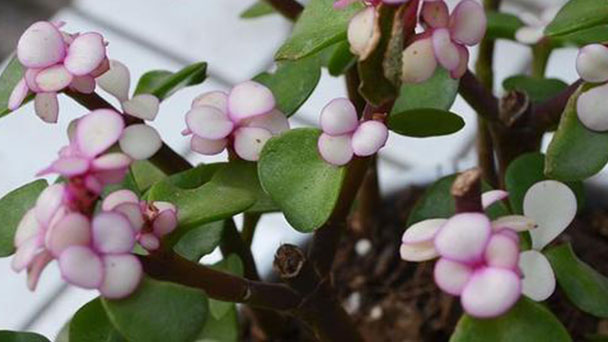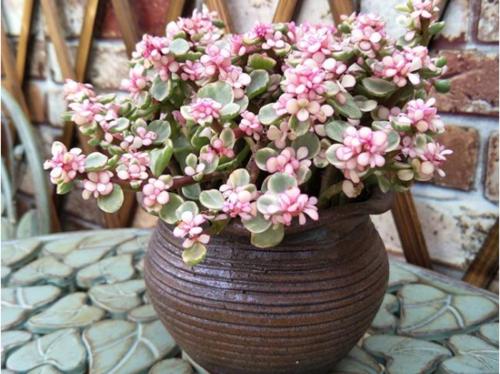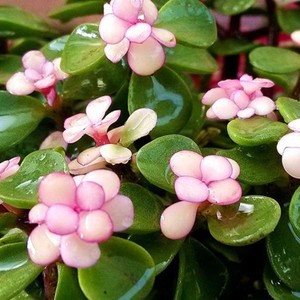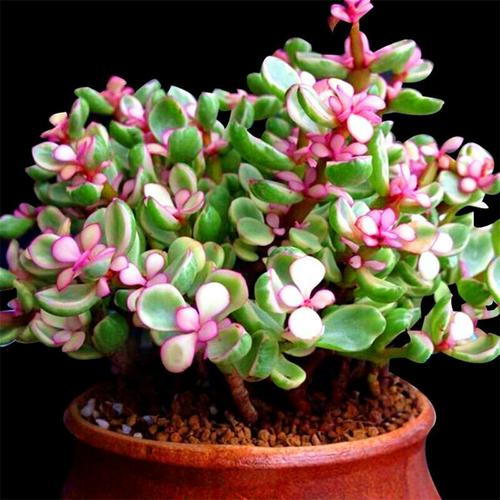Elephant Bush Profile
Written by Maggie
Nov 17 2021

Elephant bush is a tree of the genus Amaranthus found in arid areas of South Africa. It belongs to the Elephant bush family, genus Elephant bush, with the Latin name Portulaca afra.
Elephant bush stems are fleshy, purplish-brown to light brown, branches nearly horizontal, the new branches are purplish-red in full sunlight conditions, if not enough light, green.
Elephant Bush Picture
Characteristics of Elephant Bush
Elephant bush is a perennial evergreen fleshy shrub with a plant height of about 3m. It has fleshy stems, purplish-brown to light brown, branches extending nearly horizontally. The new branches are purplish-red in the condition of sufficient sunlight, or green in the case of insufficient sunlight. Leaves of elephant bush are obovate, fleshy, 1.2 to 2cm long, 1 to 1.5cm wide, 0.2cm thick, thick, crisp, green, shiny. The florets are pale pink.
Elephant bush trees can grow to a fleshy shrub of up to 4 m in their native land. Potted plants by pruning, strictly controlled height.
Elephant bush leaves are alternate or opposite, entire; Flowers bisexual, radiomorphic or zygomorphic; Elephant bush has 2 sepals, 4-5 petals, more sparse, often impotently; Elephant bush has 4-10 stamens, usually 10; Elephant bush has 1 locule, superior or semi-inferior to inferior (Portulaca), with 1 or more ovules, on basal central placenta; Fruit a capsule, capsulofid or 2-3 valvular. About 19 genera, 580 species, widely distributed in the world, north and south of China, most of them are wild.
Habits of Elephant Bush
Elephant bush is native to South Africa. It likes warm, dry and sunny environments. It is resistant to drought, semi-shade and waterlogging. Elephant bush is not resistant to cold, half shade and drought. Soil requires well drained sandy loam soil. The temperature in winter is not lower than 10℃. Elephant bush likes warm, dry and sunny environments. Elephant bush can also grow in shade, but the distance between the nodes of the stem will become longer, leaves large and thin, and dull, affect the ornamental. Summer high temperatures can be appropriate shade, in case of scorching sun exposure, and pay attention to ventilation.
Elephant bush does not have strict requirements on soil and prefers a warm, dry and sunny environment. Elephant bush cold resistance is not strong, with a certain drought resistance.

Elephant Bush Care
In the process of growth, Elephant bush needs constant pruning and shaping to maintain a beautiful plant shape. Fertilizer 1 times a month in the growing season, summer high temperature season, plants in a semi-dormant state, control watering, keep basin soil slightly dry. Winter put indoor window maintenance.
Cultivation management is more extensive, generally do not fertilize, if the growth is too weak, we can add some liquid fertilizer containing potassium or growth season every month to add a thin stale cake fertilizer water. The suitable temperature for the growth of Elephant bush is 15 ~ 25℃, and the temperature for overwintering should be kept above 7℃, and it is vulnerable to freezing when the temperature is lower than 5℃. Extreme heat and intense sunlight in summer are not good for plants. In winter, it is advisable to move the flowerpot to the sunny part of the shed to keep the leaves green. Generally 1 ~ 2 years for a basin, the soil needs loose and fertile, good drainage.
In Elephant bush growing season watering to do "not dry not watering, watering is thoroughly", avoid basin soil water, otherwise it will cause root rot. Apply decayed, thin liquid fertilizer every 15 to 20 days. Because of Elephant bush strong sprout force, you should often prune, wipe the bud, in order to maintain the beautiful tree shape.
In winter, put Elephant bush in the indoor sunny place, stop fertilization, control watering, the temperature is best above 10℃, 5℃ or so plants will not die, but the leaves will fall off a lot. Turn over the basin once every 2 to 3 years in the spring, and the basin soil can be sandy soil with medium fertility and good drainage and air permeability.
When turning over the pot, replant the Elephant bush once, cutting off the weak branches and other branches that may affect the tree's shape, cutting off part of the root system, removing 1/2 to 1/3 of the original soil, and replanting with new culture soil
Elephant Bush Benefits
Elephant bush contains abundant trace chemical elements such as potassium, calcium, magnesium, zinc, iron and phosphorus, among which potassium usually exists in the form of inorganic salts such as potassium nitrate, potassium chloride and potassium sulfate. According to the experience of the past research of the cause of clinical medicine, muscle of potassium can be internal to the human body physiological organization play a role of nutritional support, and enhance the level of activity of myocardial tissue in the body, in addition, potassium can participant the metabolism of cells in the body structure and a variety of physiological processes of enzymatic biological response, after the potassium ions into the conditions of human blood, to organizations play a direct physiological effects of blood vessel walls, which play the role of the protection of human blood vessels.

Read More:
How to Grow and Care for Elephant Bush
How to Propagate Elephant Bush
Latest Updated
- Benefits of Bugleweed - 7 Science-backed Health Benefits
- Bugleweed Dangers & Side Effects - Is It Poisonous?
- How to Plant Evergreen Trees - What You Should Know
- When to Plant Evergreens - Grow Guide for Evergreen Trees
- 12 Wonderful Evergreen Shrubs for Your Garden
- 12 Popular Evergreen Plants with Pictures for Beginners
- When And How To Prune A Lilac Bush Like a Pro
- How to Grow & Care for Lilac Vine (Hardenbergia Violacea)
- Japanese Lilac Tree (Syringa Reticulata) Care & Propagation Guide
- Shumard Oak Pros and Cons - What to Know
Popular Articles
- Winter maintenance of Antirrhinum Majus
- How to Grow Terminalia Mantaly Tree
- How to Grow and Care for Crossostephium Chinense
- How to grow Antirrhinum Majus in spring
- Peristeria Elata (Dove Orchid) Profile: Info & Care Guide
- Underwatered Snake Plant (Sansevieria Trifasciata) - Signs And How To Fix
- How to Care for Brazilian Jasmine Plant (Mandevilla Sanderi)
- How to Grow & Care for Graptopetalum Purple Delight in Summer
- Rosa Chinensis (China Rose): Plant Growing & Care Tips
- How to Care for Baby Sun Rose (Aptenia Cordifolia)
